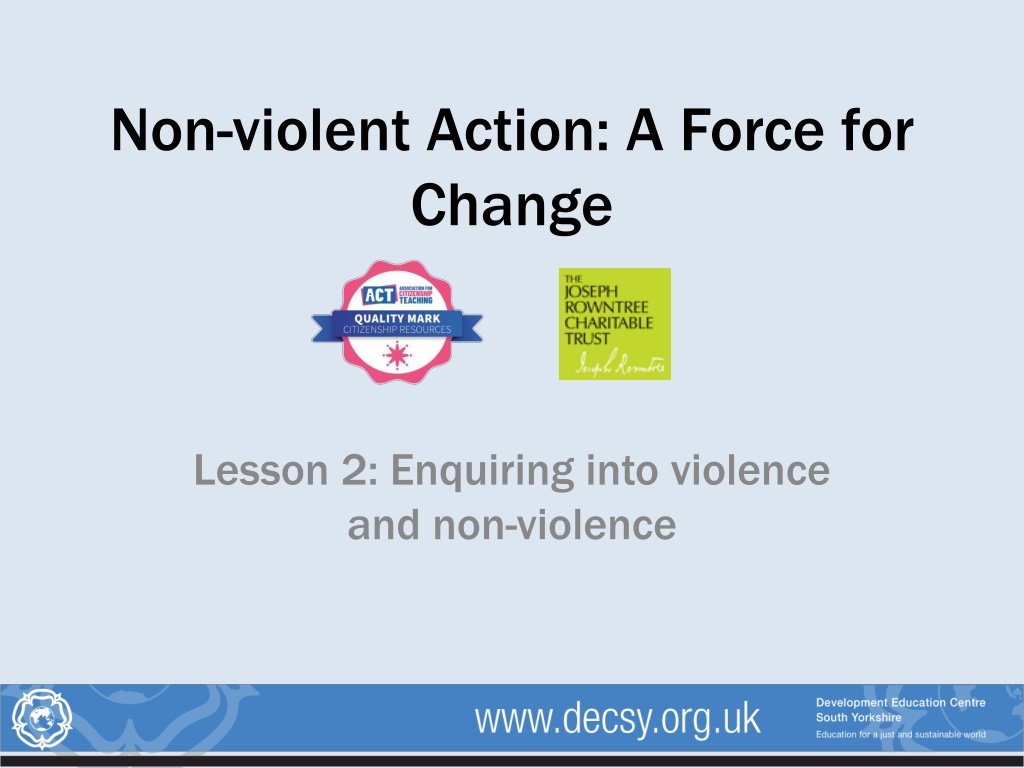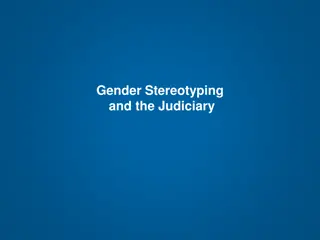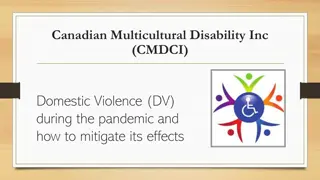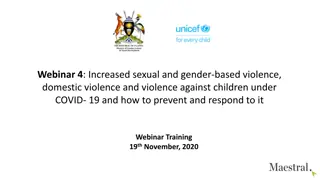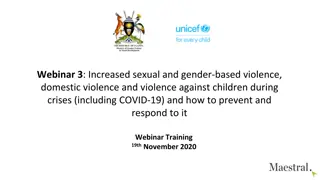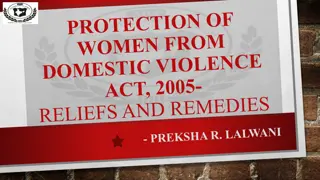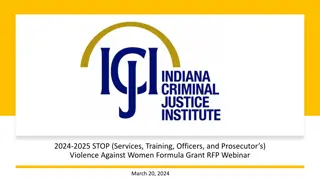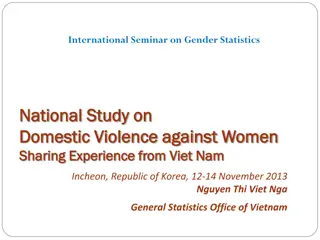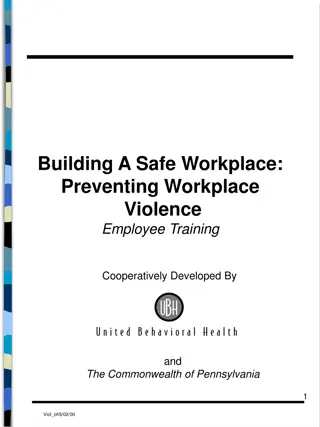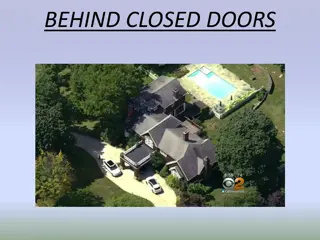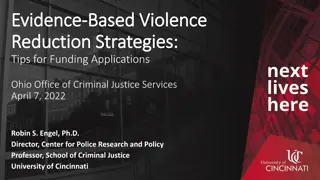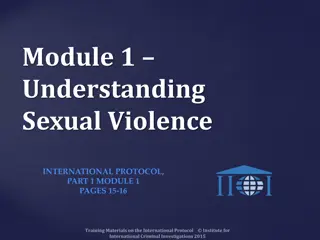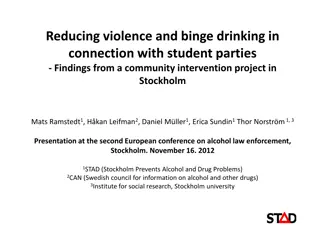Exploring Violence and Non-Violence in Actions
Explore the spectrum of violent and non-violent actions through examples like hitting back, protesting, killing animals, and more. Consider where each action falls on the spectrum and the reasons behind it. Reflect on various scenarios involving actions that range from harmful to peaceful, delving into the complexities of personal and societal choices.
Download Presentation

Please find below an Image/Link to download the presentation.
The content on the website is provided AS IS for your information and personal use only. It may not be sold, licensed, or shared on other websites without obtaining consent from the author.If you encounter any issues during the download, it is possible that the publisher has removed the file from their server.
You are allowed to download the files provided on this website for personal or commercial use, subject to the condition that they are used lawfully. All files are the property of their respective owners.
The content on the website is provided AS IS for your information and personal use only. It may not be sold, licensed, or shared on other websites without obtaining consent from the author.
E N D
Presentation Transcript
Non-violent Action: A Force for Change Lesson 2: Enquiring into violence and non-violence
Non-violentViolent Spectrum Read the examples of violent or non-violent actions and decide where to place them on the spectrum Be prepared to give your reasons Non-violent Violent
1. Hitting someone back 2. Getting hold of somebody to stop them hurting someone else 3. Shouting at politicians 4. Shouting on a march to protest against racism 5. Killing animals for sport 6. Killing animals to eat
7. Destroying or damaging a military weapon as part of a peace campaign 8. Destroying a work of art 9. An artist destroying their own work of art 10. Destroying a forest 11. Breaking a window of a house to steal the TV 12. Breaking the window of a bank investing in the arms trade
13. Bombing a city 14. Bombing a weapons depot 15. Putting a bomb through a letterbox in an unoccupied house as part of a campaign to win votes for women 16. Handing out leaflets that say things that are not true to persuade people to act against climate change 17. Handing out leaflets that say things that are true to persuade people to act against climate change
18. Swearing at someone on social media 19. Swearing at someone in real life (face to face) 20. Blocking a road to stop traffic to protest against pollution 21. Blocking a road to stop traffic to protest against pollution which might stop ambulances from getting to a hospital.
Hitting someone back Killing animals for sport Swearing at someone on social media Killing animals to eat Breaking the window of a bank investing in the arms trade Breaking a window of a house to steal the TV Getting hold of somebody to stop them hurting someone else Shouting on a march to protest against racism Shouting at someone you are angry with Swearing at someone in real life (face to face) Violent Non-violent Handing out leaflets that say things that are not true are not true to persuade people to act against climate change Handing out leaflets that say things that are true to persuade people to act against climate change are true Blocking a road to stop traffic to protest against pollution Blocking a road to stop traffic to protest against pollution which might stop ambulances from getting to a hospital Bombing a weapons depot Putting a bomb through a letterbox in an unoccupied house as part of a campaign to win votes for women Bombing a city
(Optional slide) One definition of non-violence Without violence + against violence = non-violence Vinthagen, S. 2015, A Theory of Nonviolent Action, London, Zed
against violence Handing out leaflets that say things that are true to persuade people to act against climate change Breaking the window of a bank investing in the arms trade Putting a bomb through a letterbox in an unoccupied house as part of a campaign to win votes for women Blocking a road to stop traffic to protest against pollution INTENTION Shouting on a march to protest against racism Bombing a weapons depot without violence with violence ACTION Destroying a forest Handing out advertising leaflets that say things that are not true about a product Bombing a city for violence
Principles of non-violence In groups discuss one quote each about non-violence. Identify any questions of clarification or words you don t understand. Find a way of explaining the quote so that other learners will understand it.
The principles of non-violence (used as a basis for Turning the Tides https://turningtide.org.uk/ work in the UK and in East Africa) are: Respect and care for everyone involved in a conflict, including our opponent. A willingness to take action for justice without giving into or responding with violence. A refusal to harm, damage or degrade people / living things / the earth as a means of achieving goals. If suffering is inevitable, a willingness to take it on oneself rather than inflict on others. A belief that everyone is capable of change and that the opponent s basic humanity can be reached. A recognition that no one has a monopoly of the truth, aiming to bring together our truth and the other s truth. A belief that the means are the ends in the making, so the means have to be consistent with the ends. Openness rather than secrecy. Recognising the importance of training/practice so that non-violence thinking and behaviour become part of everyday life.
The principles of non-violence (used as a basis for Turning the Tides https://turningtide.org.uk/ work in the UK and in East Africa) are (simplified version): We respect and care for everyone in a conflict, including the people we are against. We take action to make things fairer without using violence. We will not harm people, living things or the earth. We will not make other people suffer but be willing to suffer ourselves if necessary. We believe that everyone can change and it s possible to reach anybody s humanity. We know that there is not always one right answer to problems and that we may be mistaken. We believe that the way we do something should be consistent with what we want to achieve (e.g. not behaving violently to bring about peace). We try to be open in what we do rather than keeping secrets. We know it is important to learn and practice how to be non-violent so that non-violence can become part of everyday life.
What would these principles of non-violence mean in practice if they were used in: School Our local community Our national community Our global community?
